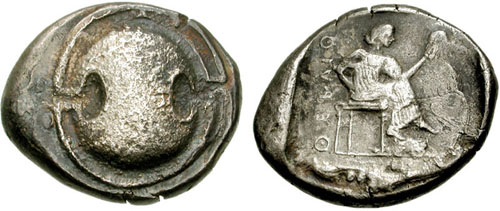450 BCE - 440 BCE | ΘEBAION
Overstriking coin
Thebes_shield_harmonia.jpg
[1]
|
|
Sale(s)Sale(s) ᵖ:
|
Classical Numismatic Group, MBS 67, 22 Sept. 2004, 530.
|
|
|
|
Description
| ObverseInscription or printing placed on the obverse.:
|
Boiotian shield.
|
ReverseInscription or printing placed on the reverse.:
|
ΘEBAION (Greek) Harmonia (wife of Kadmos), seated right on stool, holding Corinthian helmet, within incuse square.
|
Mint and issuing power
| MintIdentifies the place of manufacture or issue of a numismatic object.:
|
Thebes
|
Ancient regionAncient region.
|
Boeotia
|
Modern countryModern country: Greece
|
AuthorityIdentifies the issuing power. The authority can be "pretended" when the name or the portrait of X is on the coin but he/she was not the issuing power. It can also be "uncertain" when there is no mention of X on the coin but he/she was the issuing power according to the historical sources:
|
|
Chronology
| FromIdentifies the initial date in a range assigned in a numismatic context. 450 BCE toIdentifies the final date in a range assigned in a numismatic context.. 440 BCE
|
Classic periodTime period of the numismatic object.
|
Physical description
MetalThe physical material (usually metal) from which an object is made.: Silver 
|
WeightWeight of the numismatic object (in grams). in grams: 11.8411.84 g <br />11,840 mg <br />
|
DenominationTerm indicating the value of a numismatic object. Examples: tetradrachm, chalkous, denarius.: stater 
|
|
|
|
StandardStandard.: Aeginetic
|
References
Description
| ObverseInscription or printing placed on the obverse.:
|
Head
|
ReverseInscription or printing placed on the reverse.:
|
|
Mint and issuing power
| MintIdentifies the place of manufacture or issue of a numismatic object. ᵖ:
|
Thebes
|
Ancient regionAncient region. ᵖ
|
Boeotia
|
Modern countryModern country: Greece
|
AuthorityIdentifies the authority in whose name (explicitly or implicitly) a numismatic object was issued. ᵖ:
|
|
Chronology
| FromIdentifies the initial date in a range assigned in a numismatic context. toIdentifies the final date in a range assigned in a numismatic context..
|
Classical 480-323 BC  periodTime period of the numismatic object. periodTime period of the numismatic object.
|
Physical description
References
References
- ^ Bebelon 1914
- ^ Hoover, Oliver D. (2014), Handbook of Greek Coinage Series 4. Northern and Central Greece : Achaia Phthiotis, Ainis, Magnesia, Malis, Oita, Perrhaibia, Thessaly, Akarnania, Aitolia, Lokris, Phokis, Boiotia, Euboia, Attica, Megaris and Corinthia, sixth to first centuries BC, Lancaster, lxxi, 563 p.

